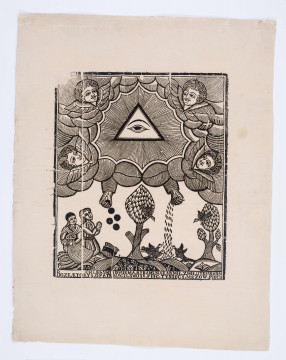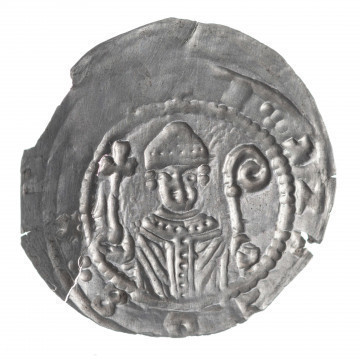Saint Ambrose
1922
National Museum in Lublin
Part of the collection: Folk Art of the Lublin Region (17th–1st half of the 20th c.)
Folk woodcarving developed in the second half of the 18th and early 19th century. In the countryside and small towns, mainly devotional pictures were distributed by monks of various congregations. Woodcutters originated from guild crafts. Their workshops were in numerous pilgrimage places. Pilgrims bought images of miraculous Christological and Marian images or images of patron saints, believing that they brought divine protection with them to their families and households. Local pilgrimage sites were also popular, including: Leśna and Kodeń in Podlasie or Radecznica near Zamość. Secular, moral or illustrative themes were rarely taken up.
The most common theme was images of patron saints with characteristic attributes. People trusted in the powers of saints, entrusted their everyday matters to their protection. Small woodcut devotional pictures were carried with them for protection or placed in various places of the house. One of these was the image of St Ambrose, father and doctor of the Church, venerated in the Catholic and Orthodox Churches as the patron saint of beekeepers and apiaries. Figural beehives in the shape of the saint, sometimes placed in apiaries, were supposed to protect bee swarms and ensure abundance of honey.
The woodcut, dating from the second half of the 18th century, was found near Kodeń on the Bug river. At the beginning of the 20th century, it was owned by priest Adolf Pleszczyński, who, in 1901, wrote the following note in the Vistula magazine: "This is, according to my opinion, a very ancient monument of our woodcarving, as indicated by the archaic inscription and the whole drawing, namely a stall and an unusually long pallium, which from the shoulders falls on the breast of St. Ambrose. The pallium was used until the fourteenth century; after that time, they are half as long, the kind now used by the metropolitans of the Catholic Church. The inscription read as follows: S. Ambrozi Patron W. [Great]. The plate seems to be of beech wood; it is much damaged by vermin. From what time does it come and can it be a contribution to the history of our wood engraving? In the 1920s the woodblock came into the possession of Father Ludwik Zalewski. In 1922, it was made available to Władysław Łazarski to make a series of prints.
Author / creator
Dimensions
cały obiekt: height: 10,5 cm, width: 14,5 cm
Object type
woodcut block
Technique
printing
Material
wood
Creation time / dating
Creation / finding place
Owner
The National Museum in Lublin
Identification number
Location / status
1922
National Museum in Lublin

1901 — 1921
National Museum in Lublin

1254
National Museum in Lublin
DISCOVER this TOPIC
Museum of King Jan III's Palace at Wilanów
DISCOVER this PATH
Educational path